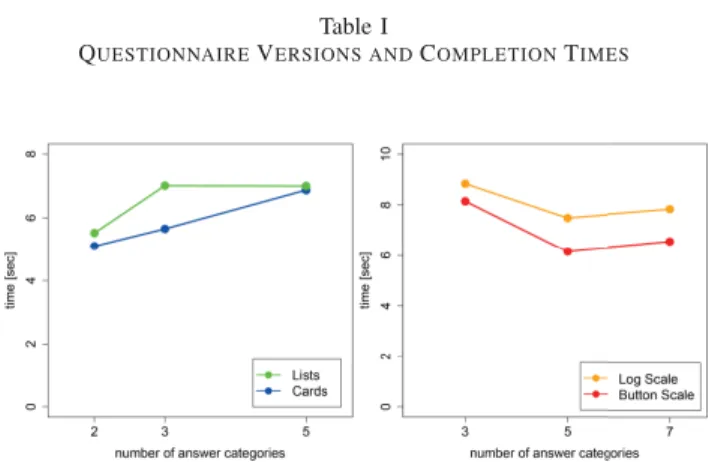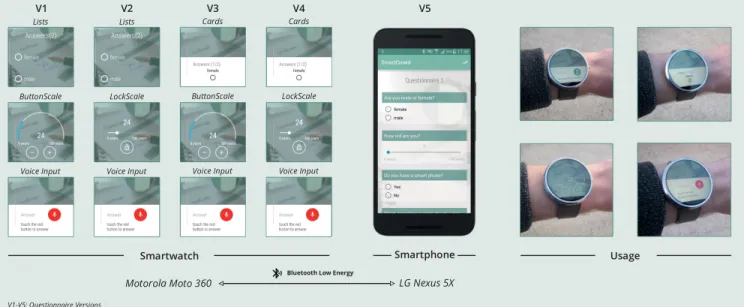Using Wearables in the Context of Chronic Disorders
Results of a Pre-Study
Marc Schickler, R¨udiger Pryss, Manfred Reichert, Martin Heinzelmann, Johannes Schobel
Ulm University
Institute of Databases and Information Systems {marc.schickler,ruediger.pryss,manfred.reichert}@uni-ulm.de,
{martin.heinzelmann,johannes.schobel}@uni-ulm.de
Berthold Langguth, Thomas Probst, Winfried Schlee University of Regensburg
Clinic and Policlinic for Psychiatry and Psychotherapy berthold.langguth@medbo.de,
thomas.probst@psychologie.uni-regensburg.de, winfried.schlee@gmail.com
Abstract—Smart mobile devices are variously used in the health sector. Some mobile applications empower patients to better understand their health problems, others guide them in health behavior. Moreover, smart mobile devices can be used in clinical research. Mobile crowd sensing has proven high usefulness for collecting health data with high ecological validity in this context. As the core idea, individually recorded health data are evaluated and fed back to individuals to better control their symptoms. For this purpose, the Track- YourTinnitus mobile crowd sensing platform was developed to empower patients to cope better with their tinnitus. So far, the platform has solely gathered patient data based on mobile questionnaires. When filling in a questionnaire, however, the analysis of the heartrate might provide novel information to medical experts. As monitoring the heartrate with smart mobile devices is costly, the trend towards wearables offers promising perspectives. Using smartwatches instead of smartphones in TrackYourTinnitus, however, requires questionnaire manage- ment on smartwatches. This work presents results of a pre- study related to the feasibility of sophisticated questionnaires on smartwatches. A prototype was developed and evaluated with 24 subjects. The obtained results are promising regarding the use of smartwatches for mobile crowd sensing in the context of chronic disorders.
Keywords-Mobile Data Collection, Smartwatch, Patient Em- powerment, Mobile Crowd Sensing, Personalized Healthcare
I. INTRODUCTION
The tinnitus disorder (ringing in the ear) is characterized by the perception of a sound in the absence of a correspond- ing acoustic stimulus. It is a highly prevalent disorder being difficult to treat. Recently, mobile crowd sensing emerged as an approach for collecting large and ecological valid datasets at rather low costs. By providing mobile crowd sensing services to huge numbers of patients, large datasets can be gathered cheaply on a daily basis. In the TrackYourTinnitus (TYT) project [1], a mobile crowd sensing platform was developed to reveal new medical aspects on tinnitus and its treatment. Currently, the platform solely gathers patient data based on mobile questionnaires processed by patients on their smart mobile device. When filling a questionnaire for medical experts, the analysis of the heartrate might be another promising data source. In this context, the use of
Subjects Smartwatch Smartphone
V1 V2 V3 V4 V5
Avg. completion
203,13 243,27 208,22 223,74 198,63 time (sec.)
Table I
QUESTIONNAIREVERSIONS ANDCOMPLETIONTIMES
Figure 1. Evaluation of List/Cards and LogScale/ButtonScale
smartwatches and their integrated sensors for measuring the heartrate seems to be a feasible approach. From a technical perspective, two issues are crucial regarding their use in the TYT project. First, mobile questionnaires need to be deployed to smartwatches. Second, it must be evaluated whether smartwatches are able to robustly measure the heartrate while filling in a questionnaire. This work deals with the first issue and presents results from a pre-study that revealed promising results in this context.
Section II introduces the setting of the pre-study, whereas Section III presents results. Section IV discusses related work and Section V concludes the paper.
II. PRE-STUDYSETTING
The technical equipment used for the pre-study were a Motorola Moto 360 smartwatch and a LG Nexus 5X smart mobile device. The technical prototype we realized addressed the following elements of a digital questionnaire:
navigation (i.e., how to navigate between questions), input elements (e.g., lists), text appearance (i.e., addressing screen
Figure 2. Questionnaires on Smartwatch and Smartphone
size limitations), and text input (i.e., how to provide text input). Based on this, a questionnaire consisting of 18 questions addressing fundamental questions related to TYT was developed in 4 different smartwatch versions (cf. Fig.
2, V1-V4). The latter were required to evaluate the different input elements. Furthermore, version 5 of the questionnaire was provided on the smartphone itself. The latter allows comparing the results obtained for the smartwatch and smart mobile device respectively. Note that text input can be provided based on voice input. Further, two additional input elements were realized (cf. Fig. 2,ButtonScale, LockScale).
III. PRE-STUDYRESULTS
24 subjects processed four questionnaires on the smart- watch and one on the smartphone. Three selected results are presented. First, the duration to process questionnaires depends on the input method (e.g., scales) and the number of possible answers. Specifically, the scales show an advantage for questions with a large number of answer categories, while the cards and lists show an advantage for questions with a small number of answer categories (cf. Fig. 1).
Second, ButtonScale requires less time than LogScale. More precisely, 79% of the subjects prefer the ButtonScale over LockScale. Cards, in turn, require less time than lists.
Furthermore, 54% of the subjects preferred cards, while 42% preferred the list. (cf. Fig. 1). Third, the observed times to process a questionnaire on the smartwatch and the smartphone were surprising. The average duration to finish the questionnaire with the smartwatch was 215.4 seconds, while the average duration with the smartphone was 198.6 seconds. This, together with observations made for other recordings, indicate that smartwatches constitute a proper alternative for smartphones in the context of smart mobile
data collection. Further studies are required to appropriately evaluate the use of smartwatches in the long run.
IV. RELATEDWORK
The assessment of vital parameters in various life situa- tions has been considered by other approaches as well [2].
Smartwatches have been already proposed as an assessment tool for movement disorders [3]. To the knowledge of the authors, their use in combination with mobile crowd sensing on chronic disorders is still a largely untapped field.
V. SUMMARY ANDOUTLOOK
The pre-study revealed that smartwatches may be used as alternatives in the context of mobile crowd sensing platforms making use of mobile questionnaires. A specific advantage are their integrated sensors, which may provide additional insights about the health state. Further research for their validation and for the evaluation of their long-term use are required. Altogether, smartwatches seem to be a valuable device type for mobile crowd sensing on chronic disorders.
REFERENCES
[1] R. Pryss, M. Reichert, B. Langguth, and W. Schlee, “Mobile Crowd Sensing Services for Tinnitus Assessment, Therapy and Research,” inIEEE 4th Int’l Conf on Mobile Services. IEEE Computer Society Press, 2015, pp. 352–359.
[2] S. Hardy, A. El Saddik, S. G¨obel, and R. Steinmetz, “Context aware serious games framework for sport and health,” in Int’l Workshop on Medical Measurements and Applications Proceedings. IEEE, 2011, pp. 248–252.
[3] D. J. Wile, R. Ranawaya, and Z. Kiss, “Smart watch ac- celerometry for analysis and diagnosis of tremor,”Journal of Neuroscience Methods, vol. 230, pp. 1–4, 2014.

